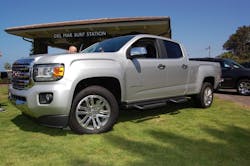DEL MAR, CA. General Motors is touting the overall “efficiency” of its new 2015 Chevrolet Colorado and GMC Canyon midsize pickup trucks in terms of fuel economy and work capability as the new vehicles begin being shipped to U.S. dealers.
“There are 12.5 million midsize pickups on the road in the U.S. today – representing about 5% of all vehicles on our roads,” noted Kenn Bakowski, marketing manager for the GMC Canyon, here at a special ride and drive event for journalists.
[Click here to view more photos from this event.]
“This gives you the sense of the opportunity we believe is out there,” he said. “And efficiency is the nature of the beast here in terms of fuel economy, maneuverability, parkability, payload and towing. That’s the whole formula: efficiency paired up with capability in a truck that is easy to live and work with.”
Duncan Aldred – installed by GM as U.S. VP for Buick and GMC back in March after serving as chairman and managing director of Vauxhall Motors and CEO of Opel Ireland – added that GMC is outpacing most of GM’s other divisions in terms of sales (up 8% year-over-year) and transaction price per vehicle; up 10% in 2014 alone to reach the highest level ever attained at the division.
“We got an opportunity here to appeal to a whole new audience with the Canyon and Colorado,” he said. “It’s an opportunity to bring new people to the GMC brand.”GM noted that when powered by its 2.5 liter I-4 four-cylinder engine in two wheel drive configuration mated to a 6-speed automatic transmission, the Canyon and Colorado will offer an estimated 20 mile per gallon (mpg) in city driving and 27 mpg in highway driving , for a combined 22 mpg rating overall, according to Environmental Protection Agency (EPA) tests.
By contrast, four-wheel drive versions of the new 2015 mid-size models will sport EPA-estimated ratings of 19 city mpg and 25 mpg highway for a combined 21 mpg.
When equipped with the 3.6 liter V-6 engine, payload ratings for the Colorado and Canyon are 1,590 pounds and 1,620 pounds, respectively. The difference is due to slight differences in curb weigh as the Canyon comes standard with alloy wheels, whereas the Colorado features slightly heavier steel wheels.
The OEM added that its 2.5 liter I-4 has been rated at 200 hp and 191 lb.-ft. of torque, while the 3.6 liter V-6 is rated at 305 hp and 269 lb.-ft. of torque.
GM – which began shipping the Colorado and Canyon to its dealers last week – noted that for the 2016 model year, it will make a 2.8-liter Duramax turbodiesel engine available as an option for its midsize pickup line.
“Fuel economy is big with these new trucks,” Anita Burke, GM’s vehicle chief engineer for midsize trucks, told Fleet Owner.
“It’s an everyday activity for these trucks, whether they are operating on the highway or in the city, and every engineering decision we made when developing the Canyon and Colorado kept fuel economy in mind – from the materials to the exterior styling and technology inside them,” she said.
GM also pointed out that both the Colorado and Canyon benefit from technologies like cabs and frames made with more than 72% high-strength steel, available “active aero shutters” on the front grille to make the truck more aerodynamic as needed, and available OnStar with 4G LTE, turning these trucks into “rolling Wi-Fi hotspots” for up to seven mobile devices to connect to the Internet.
Burke stressed, too, that “not everyone needs a full-size truck” to get their respective work done.
“That’s why it’s all about cost efficiency and why we need to offer truck models for every customer need,” she explained. “We have a global midsize truck and full-size [pickup] models here in the U.S., so we took what we learned from developing both of them to design a midsize vehicle for this market.”
About the Author
Sean Kilcarr
Editor in Chief
Sean Kilcarr is a former longtime FleetOwner senior editor who wrote for the publication from 2000 to 2018. He served as editor-in-chief from 2017 to 2018.

